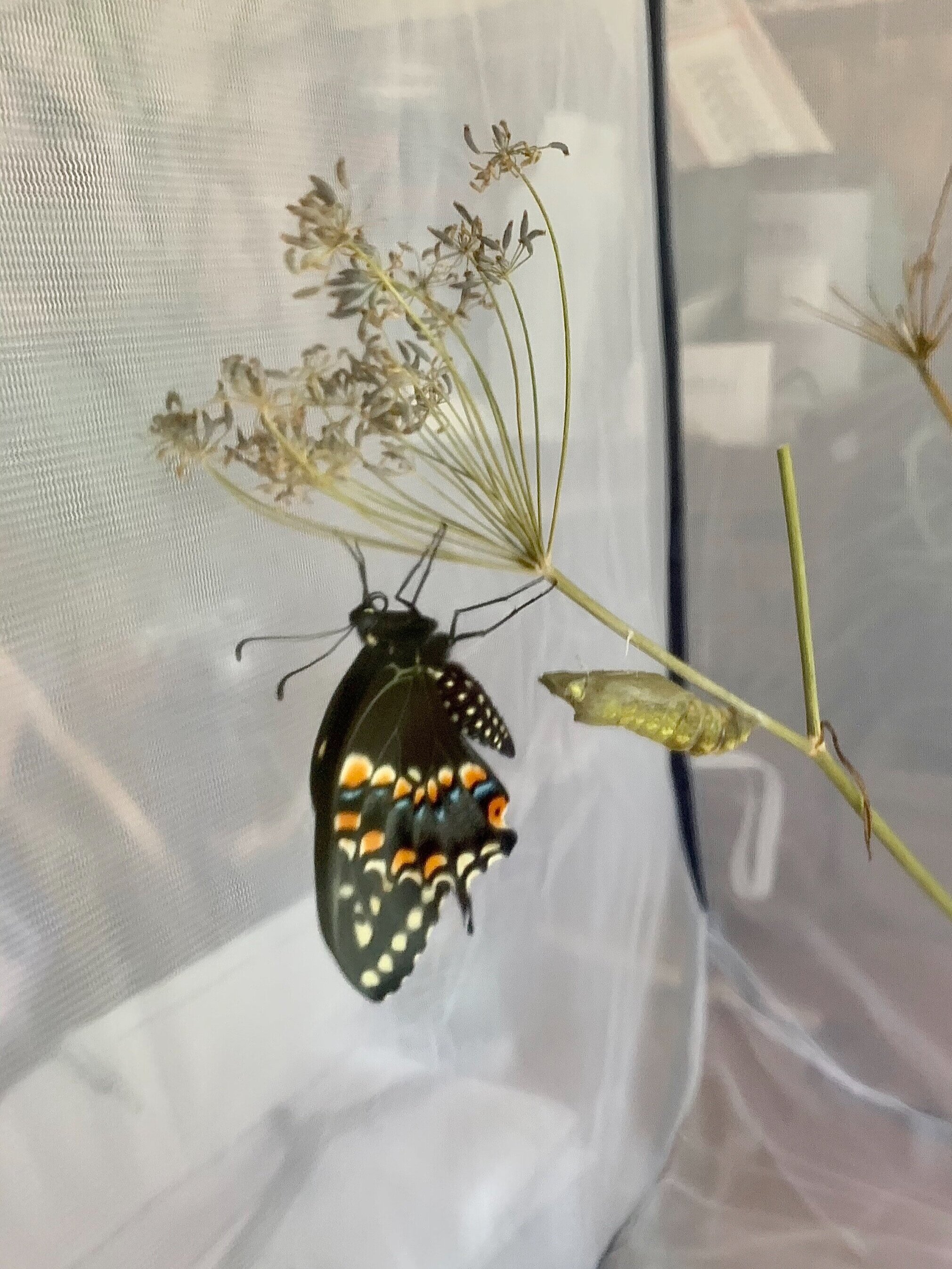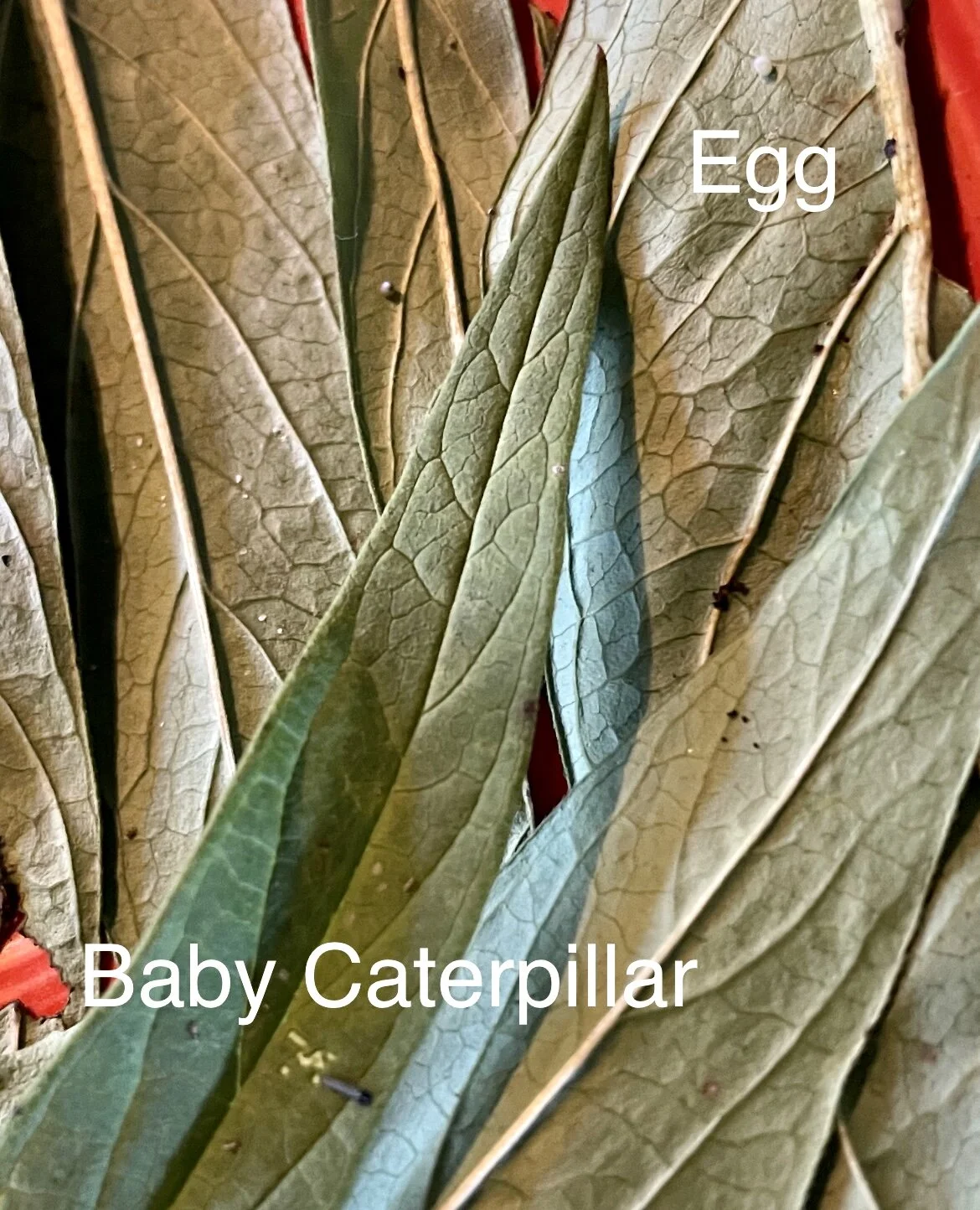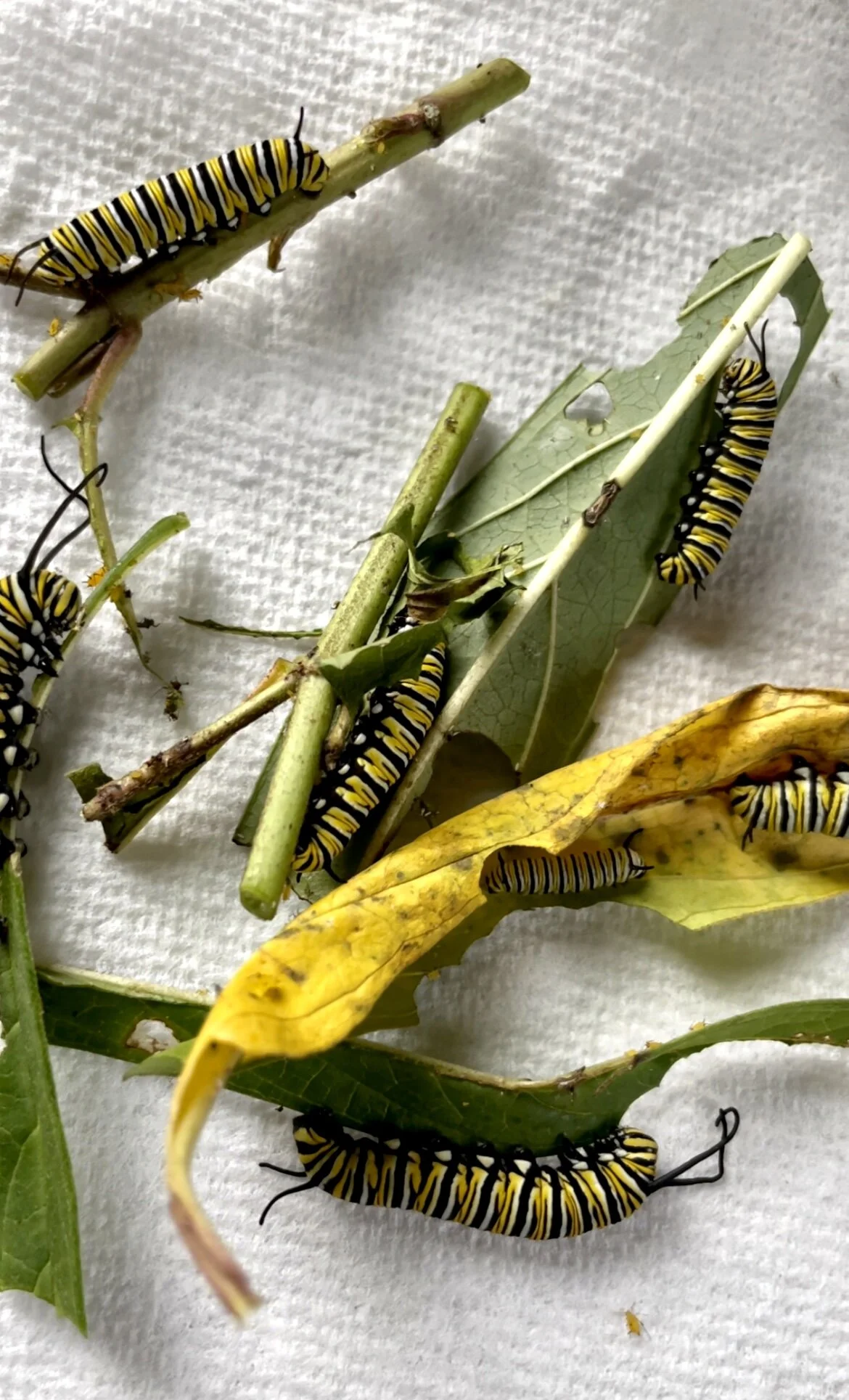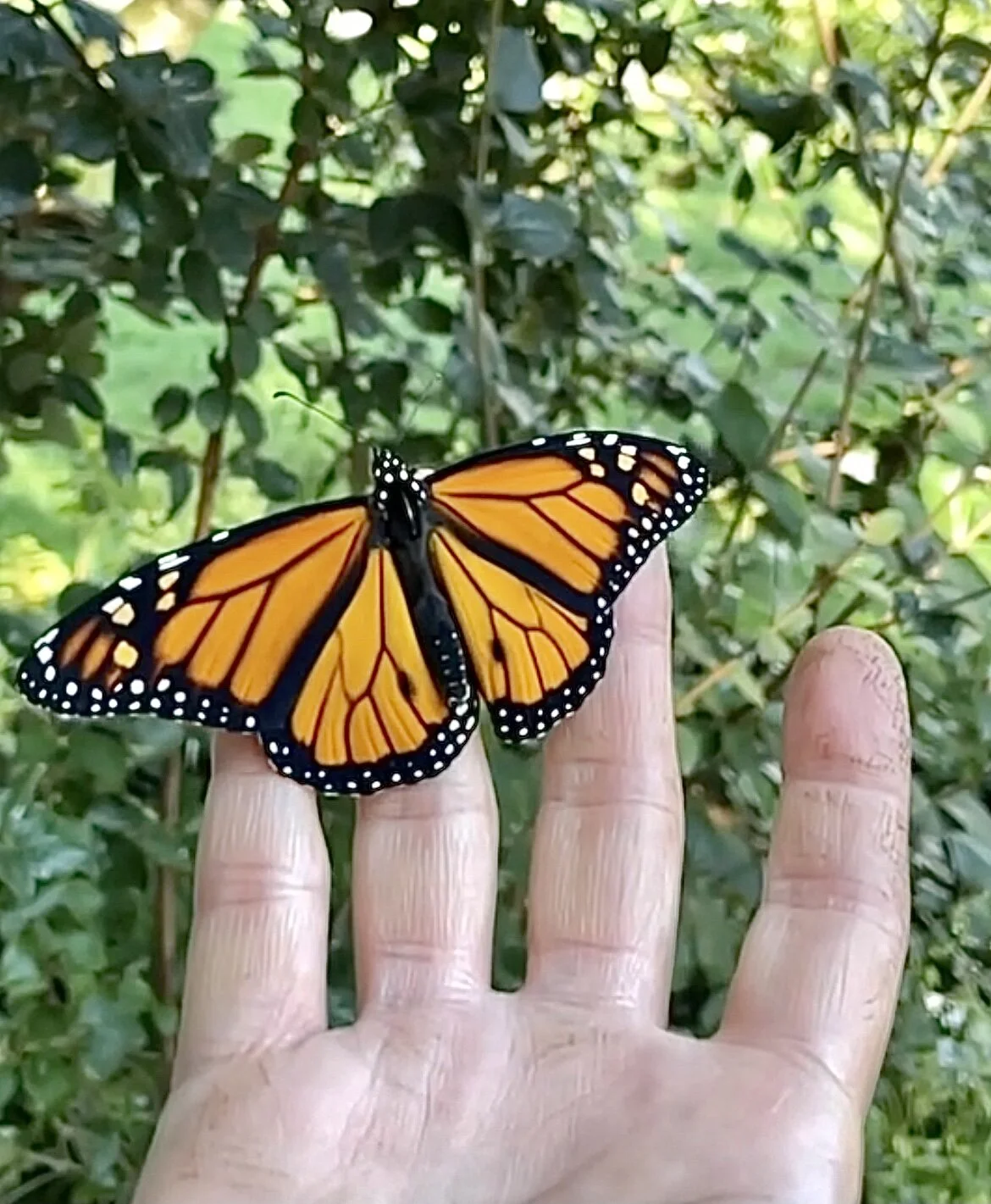How to Raise Butterflies Indoors
black swallowtail after emerging from it’s chrysalis, inside of our rest cloud netted habitat (link below)
Updated for 2021-
Raising Butterflies
It's important to preface this with, I AM NOT AN EXPERT! This is our second year raising butterflies indoors, but we have learned a lot in the meantime and thought I would share since we have been getting a lot of questions about it. It is very easy once you have the basics down.
How We Began
Last year I noticed that we seemed to have not as many caterpillars, both swallowtail and monarch on our plants--even though we have an abundance of plants for them to feed on-- and realized that we have a TON of birds, which we typically encourage and love, but we thought they might be eating the caterpillars as food and preventing them getting to chrysalis and hatching stage.
I got some tips from a friend and it quickly turned into an obsession! Raising the caterpillars into butterflies is really easy once you know what to do, and this year we have released 15 swallowtail and 8 monarchs with a few more still to go.
So here is a little guide for you all on how you can do this yourselves at home. Keep in mind there is a LOT more to learn about caterpillars, butterflies etc than I have listed here, this is just what we have learned over the last 2 years; google and YouTube have a lot of info as well.
Identification & Plants:
There are many types of caterpillars out there. Even the ugly tomato hornworm turns into something beautiful (hawkmoth). But what we have an abundance of here on our farm is black swallowtail and monarch caterpillars, specifically because we grow a lot of dill, parley, fennel which is a host plant for the black swallowtail and milkweed which is the host plant of monarch.
Learn about your host plants.
Caterpillars need specific host plants to feed off of--and then once they mature into a butterfly, they need nectar plants to feed off of. So in your gardens you need to have both host plants for the caterpillars; and feeding plants for the mature butterflies. Most people just think of nectar plants which would be for AFTER the hatch. And that is important too but if you don’t have the caterpillar host plants in your garden, then you won’t find any caterpillars to bring inside.
While most butterflies consistently will love common nectar rich plants, aka if you have an echinacea, pretty much ANY pollinator or butterfly will feed off it; while they are in the caterpillar form, each specific type has a different host plant.
Black swallowtail host plants for caterpillars: dill, parsley, fennel are very common ones
Monarch host plants for caterpillars: milkweed only (but there are 4-5 varieties of milkweed)
Yellow swallowtail host plants for caterpillars: a variety but spicebush is popular for it
Google also will have other recommendations for you if you look them up.
Grow these types of plants in your garden to encourage the adult butterflies to lay their eggs on them and then you will be able to go out and find caterpillars on them to bring inside.
Caterpillars typically go through multiple 'instars' aka transformation stages from egg to caterpillar and then to sac and hatching. You can google to see specific stages; but it's good to know what the various stages look like so that when you find something on your plant, you can identify it readily. This year I really learned more about how to identify the eggs on the milkweed for monarchs which led to more success finding them and bringing them in before they got to the caterpillar stage and therefore the ‘yummy munch’ stage for birds.
Bringing them Inside:
When you find an identifiable egg, or a baby caterpillar on your plants, then you can bring them inside. It’s easiest on them if you bring them in young. Sometimes if you bring the caterpillars in too close to pupation stage, they will stress out and pupate early and it can lead to death. Don't worry about them wandering off, they want to stay with their host plant and all they do is EAT EAT EAT. So you can bring in an entire plant so it stays alive, but we also just cut the stems and bring them in and put them in a vase for them with water. You'll have to switch out the water every 3-4 days. Just don't rinse a caterpillar down the sink too.
While they are in this 'eat everything in sight' stage you do not have to worry about them wandering off. They can literally just stay in a vase on your dinner table if you want BUT keep in mind, growing caterpillars poop like crazy. The poop is hard pebble type things so don't worry about it staining anything, and all we do is take a napkin or small brush and brush them off the table into the trash can every other day. Or you can put a little container under the vase to catch them and then just toss the pan into the garden every few days. But it's fun to keep them somewhere you can see them as they grow. As they move through each instar phase, they shed their skin, and sometimes you'll find the shed skin on the table/floor along with their poop.
multiple monarch caterpillars munching on milkweed. the orange are aphids which love milkweed but do not harm it or the caterpillars.
After our first year, we got smart and now use a zippered laundry net for each type of butterfly, so we have one for monarchs and one for swallowtails. This just makes it easier to monitor. Make sure they have enough to eat. Keep adding stems of their host plant, whatever it is, to the vase or your container to make sure they can eat til they are ready to make the transformation into their pupate form which is when they enclose themselves and make the final transformation into butterfly.
Google has been super helpful to me too this summer. 'My caterpillar is doing weird things' is pretty common ... aka 'caterpillar curling around stem' or 'caterpillar pupated into a brown sac' ... and while we have had a few misses, aka a caterpillar dying for no apparent reason or similar, our success rate has been 99% so they are pretty darn easy.
The Chrysalis Stage:
Ok so now your caterpillar has grown from a tiny spec into a beast and is getting ready to make his transformation sac. At this point you will figure this out by a) him making a giant poop with water in it, which is him expelling all the undigested food from his system and b) he starts to wander around looking for a good place to rest for the next 7-10 days.
This is when you should enclose them if you have not already.
I know this from experience. They travel ALL OVER. I lost one in our sunroom (should see a butterfly any day now in our house lol) and stepped on another one :( And while you don't HAVE to enclose them for them to find a place and make a sac, it's safest for them if you do enclose them. I bought a zippered net on amazon--after trying a few that were not zippered, get the zippered butterfly net. It will give you so much peace of mind. And it's like $14.
This year I got smart and just enclosed them at the start, so I didn’t have to worry about any timing, they can just do their thing. Most of ours pupate directly on the edges or corners of the net, along a 'structured' area though I have had a few literally just do it on the soft part of the net.
You can try to watch and wait for the transformation but it often happens at night and it happens quickly, within about 5minutes. They shed their skin one last time and cover themselves with the chrysalis and now they rest and make their transformation. There have been times when I go outside and come back in and the caterpillar is now a chrysalis.
Monarch chrysalis are always green and hang vertically straight down. Black swallowtails create a sling and hang at a 45 degree angle from an anchor; also the swallowtails will camouflage themselves so sometimes their chrysalis are brown, other times green. Don’t worry if yours is brown, it’s probably trying to match the branch or similar.
Usually our swallowtails emerge about 8-10 days afterwards, but some can take longer.
Monarchs can take about 7-14 days on average. While they are in this form, you do nothing. I just try not to disturb them too much during this time.
As they start to get towards the final stages of transformation you will see the chrysalis turn from bright green or brown (if it's on a stick or similar, camouflage) to a very dark color and get more translucent. Sometimes you will even see the flashes of the yellow or blue or orange start to show through the thinning membrane. This is how you know they're getting close.
Hatching happens very quickly, we often miss this as well! We will look and there’s a butterfly hanging off it’s chrysalis. They need a few hours to dry their wings, and when they start to move around in the enclosure and seem to have their 'sea legs', I reach in and scoop them up gently (ours never seem to climb onto my hand and stay there, so I cover them with my other hand and make a scoop)...and then rush them to the door and put it on a bush or plant outside...where usually it takes off immediately and you see it fly away. You don’t want to keep it in the enclosure too long after hatch because they will want to feed—so if you are not able to release them within about 5-6 hours, bring in some nectar plants/flowers for them to feed off of.
That's it! It's very easy once you know things to look for and how to take care of them inside..and you really don't need many supplies at all. It's a bit late to plant any of the host plants for this year, but for next year make sure to put some plants that the caterpillars love so that you can start scouring them in summer for the caterpillars and make your own butterfly hatching project! It's so fun especially for kids.
Nectar Plants:
After you’ve released the butterfly, it may or may not stick around, and you’ll never really know. But by including nectar/feeding plants for the mature adults, the chances are you’ll have them always around. And you want the adults around because they lay the eggs for the next round of caterpillars on your host plants. So keep things such as echinacea, ascelpias, agastache, rudbeckia, lavender, ironweed etc around your garden if you want to encourage adults. Butterfly bush is a popular one that people add in but be sure to keep an eye on the variety you bring in, this is not a native plant and many can become invasive. Make sure to deadhead your nectar plants if they bloom too early in the season to be food for the butterflies. You want to keep them blooming as long as possible.
I can’t stress enough about Googling and reading up on other websites about this as well. There is a ton of info online about this and it is how I learned most of what we were able to achieve this year.
If you go this route because I encouraged you--please tag me in photos or stories. I would love to see it!
If you have been doing this and have other tips, please add them in the commends below!
List of Supplies:
eastern black swallowtail caterpillars in various instar stages munching on one of their host plants, fennel
If you want to get started immediately and don’t have the right host plants in your garden or caterpillars to get going… you can always ‘cheat’ and buy an online kit. But I would definitely encourage to plant some of the proper host plants so that next year you can have a butterfly making machine in your backyard! Start checking your plants in early summer for eggs and caterpillars. Ours go until usually mid September.
Super short list of supplies, don’t buy too many fancy things. -You need host plants for the caterpillars & a zippered net for when it’s time to enclose them. That’s it really! Anything else you can just use from around the house (aka vase for the host plants, paper towels for the poop etc).
If you want a full on kit, info below.
Full Butterfly Kit, this comes with everything you need to get started; including a voucher for live caterpillars if you do not want to wait to get started.
If you wanted to just get some caterpillars and a net and try it…here you go.
Caterpillars: a set of 5 or 10 caterpillars to get you started (but next year plant the host plants!)
Net that we like: Restcloud insect and butterfly habitat-important that it is zippered!






